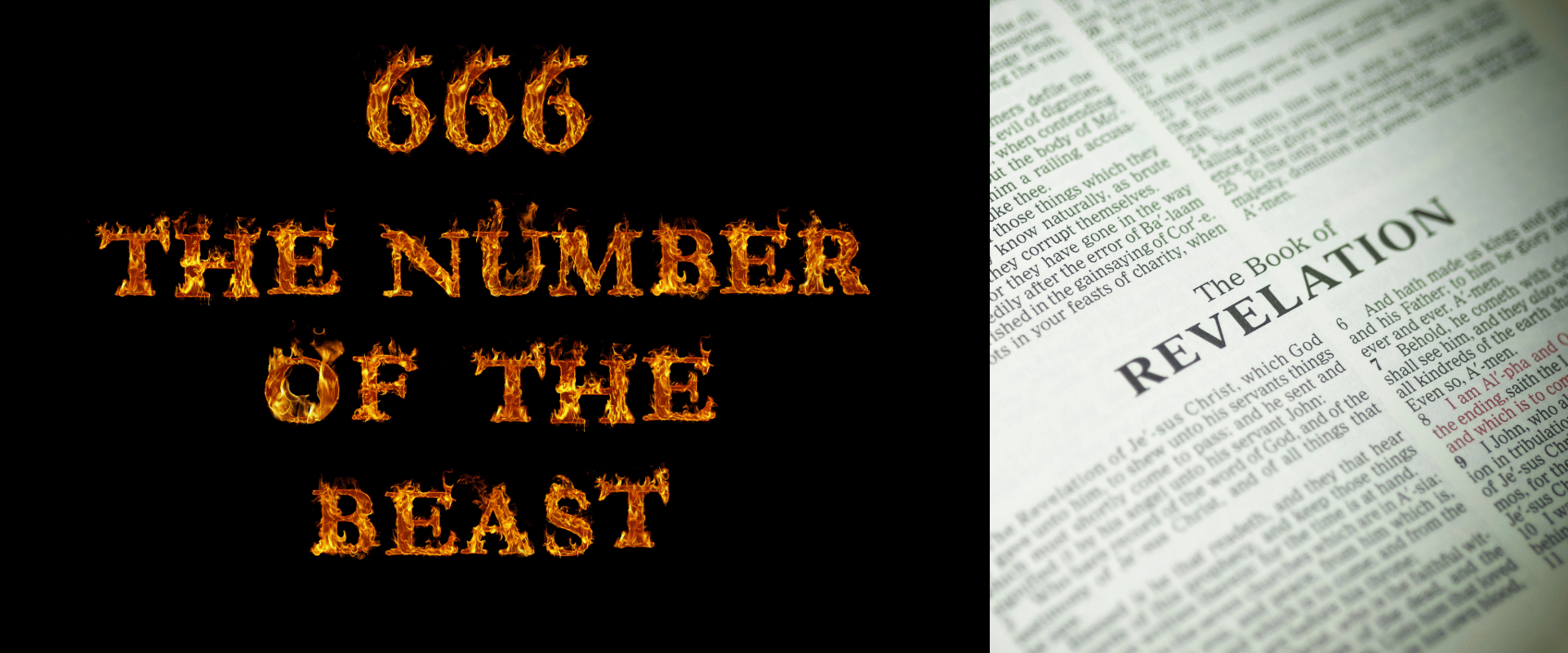666: The Actual Number of the Beast?

Written by Marko Marina, Ph.D.
Author | Historian | BE Contributor
Verified! See our guidelines
Verified! See our editorial guidelines
Date written: July 15th, 2024
Disclaimer: The views and opinions expressed in this article belong to the author and do not necessarily match my own. - Dr. Bart D. Ehrman
A couple of months ago, I participated in a pub quiz. These events are actually quite popular in Croatia! They are both fun and educational, filled with lots of interesting questions and puzzles. That particular time, one question stood out. We were presented with a white horse, green horse, red horse, black horse and a pale horse.
One of those doesn't belong there. We had to figure out which one and why. No additional context was provided! Nevertheless, my mind immediately recognized the crucial background: The puzzle was referring to the Four Horsemen of the Apocalypse mentioned in Revelation 6.
The Book of Revelation, one of the most fascinating texts of the New Testament, is particularly known for its vivid imagery and symbolic numbers. Among these, the so-called number of the beast, 666, stands out as one of the most intriguing and mysterious elements.
This number has captured the imagination of people for centuries, inspiring countless interpretations and speculations.
In this article, we’ll delve into the historical and textual background of 666. We want to unravel its origins, understand its meaning, and explore the discrepancies found in early texts — specifically the variation between 616 and 666.
By examining these aspects, we hope to shed light on the true significance of the number of the beast and its place in Biblical scholarship.
Whether you're a Biblical scholar or simply curious about this iconic number, this journey promises to be both enlightening and engaging. And no, I won't spoil the answer to the pub quiz question mentioned above — some mysteries are best left for you to ponder.
Before we begin our journey, I must tell you about an amazing opportunity! Join Dr. Bart D. Ehrman in his webinar “Will You Be Left Behind? A History of The Rapture”, where he delves into the meaning of the Book of Revelation from a historical perspective.
Discover whether Revelation predicts our future and unravels the mysteries behind concepts like the Rapture and the Antichrist. Don't miss this insightful exploration into one of the most intriguing books of the Bible. Register now!

Letters and Numbers in the Ancient World: Understanding the Context
To delve deeper into the historical origin and meaning of 666, it's essential to first understand the numerical systems used in ancient times. Unlike our modern system, which separates alphabetical and numerical symbols, ancient languages like Hebrew and Greek used their letters as numerals.
As Bart D. Ehrman explains in his excellent book Armageddon: “Neither Hebrew nor Greek used different alphabetical and numerical systems the way we do when we use the Latin alphabet (a, b, c) but Arabic numerals (1, 2, 3). In these ancient languages, the letters of the alphabet served also as numerals.” (Affiliate Disclaimer: We may earn commissions on products you purchase through this page at no additional cost to you. Thank you for supporting our site!)
This dual role of letters gave rise to a fascinating interpretive practice known as gematria. In Jewish tradition, and therefore, in the Old Testament as well, each letter of the alphabet had a numerical value.
This meant words and names could be translated into numbers, and conversely, numbers could be interpreted as words. For example, in Hebrew, the letter aleph (א) is 1, bet (ב) is 2, and so on. This practice allowed for a range of symbolic interpretations and was often used to uncover hidden meanings within texts.
Consequently, gematria played a significant role in biblical exegesis and interpretation. In the context of the number 666, gematria offers a compelling explanation. The number 666 can be understood as a coded reference, where the numerical value points to a specific name or word.
By understanding gematria, we gain insight into how ancient readers might have deciphered the number 666, seeing it not just as a random figure but as a meaningful symbol within their religious and cultural framework.
The Book of Revelation and the Number of the Beast
The Book of Revelation is probably the most fascinating piece of literature in the New Testament. The author calls himself John, and there is no compelling reason to doubt it was his real name. However, the author doesn’t claim to be the Apostle John. He says he experienced his revelation while he “was on the island called Patmos because of the word of God and the testimony of Jesus.”
Furthermore, Revelation is a type of work known as the Apocalypse. As such, it most closely resembles the Book of Daniel in the Old Testament. As with Daniel and other apocalyptic works, the visions John receives are highly symbolic. Therefore, of course, there have been all sorts of interpretations, especially about the number of the beast.
Writing at the end of the 20th century, Adela Y. Collins noted: “The puzzle of 666 continues to fascinate and inspire ingenious solutions. Sometimes this mysterious number is interpreted as a reference to a personal Antichrist or False Messiah. Mussolini, Hitler, Henry Kissinger, and Anwar Sadat have been so identified in this century.”
Numbers, therefore, play an important role in Revelation. Plagues, trumpets, seals, and other elements often come in specific numbers — most notably seven, implying completion or wholeness.
The precise numbering of the objects and the use of meaningful numbers such as seven indicate that Revelation’s events may seem chaotic and strange, but God has planned an order behind everything that happens.
In this context, the number 666 appears as a significant and mysterious symbol. It’s in Revelation 13:18, a passage that has intrigued and puzzled readers for centuries.
The verse states: “This calls for wisdom: let the one who has understanding calculate the number of the beast, for it is the number of a man, and his number is 666.” This passage is part of a larger vision involving two beasts, one from the sea and one from the earth, which play central roles in the apocalyptic narrative.
The number 666 is described as the number of the beast, a figure representing evil and opposition to God. This beast exerts considerable influence and power, leading many to worship it. The directive to “calculate the number” indicates that 666 is not a random number but one that carries a specific meaning, possibly pointing to a particular individual or concept.
Who is Behind the Number of the Beast?: Interpreting the Meaning of 666
Understanding the Book of Revelation requires situating it within its historical and social context. Many people naturally assume this book predicts events yet to come in our future. This has been a common interpretation through the ages, with each generation believing that Revelation foretells imminent events in their time.
Did You Know?
Not everyone thinks the number 666 hides a particular person. Jehovah's Witnesses interpret 666 in the Book of Revelation as a symbol for the worldwide political system controlled by Satan. They believe the number represents imperfect human governments collectively, which are inherently flawed and opposed to God's Kingdom.
According to Jehovah's Witnesses, therefore, the number 666 doesn’t refer to any individual ruler, such as the Pope. Instead, it signifies all human political entities that demand loyalty and worship, placing them in direct opposition to God.
However, every generation has been wrong so far, even though each new one thinks it will surely be the one to witness these prophecies. Luckily, an alternative approach exists: Understanding the book in its historical and social context.
In The New Testament: A Historical Introduction, Bart Ehrman notes: "A historian who wants to understand this one ancient text, then, will situate it in the context of this related literature and explain its important features in light of the literary conventions of the genre." When we do this, we can uncover the mysterious person behind the number 666.
First and foremost, Revelation presents a dualistic worldview, a common feature in the apocalyptic literature of the ancient world. In this view, there are two kinds of people: true Christians and everyone else. These groups worship one of two beings: God or the demonic beast.
At the end of chapter 12 and the beginning of chapter 13, a dragon representing Satan introduces the beast symbolizing Rome and its emperor. This depiction of the beast draws on the seventh chapter of Daniel, and the four beasts that appear in it.
Furthermore, the angel tells John that 666 is the number “of a man.” This means we should be looking at a specific individual. Considering that John is especially incensed that the beast is persecuting Christians, the person we are looking for must be a Roman Emperor. But which one?
In Armageddon, Bart D. Ehrman explains: "The first Roman emperor to do so [persecution of Christians] was Nero, who ruled from 54 to 68 CE. And this is where the gematria kicks in: if you spell “Caesar Nero” in Hebrew letters, the name adds up to 666... But why would the author be referring to the name as spelled in Hebrew rather than Greek? Numerological puzzles are inherently intriguing, and perhaps John is simply heightening the mystery.”
Elaine Pagels, in her book Revelations: Visions, Prophecy, and Politics in the Book of Revelation, supports this view: "Although John held all emperors in contempt, he chose Nero — who was said to have burned Jewish followers of Jesus alive to illuminate his garden — to epitomize “the beast” that was Roman rule... Some still debate its meaning, but many now agree that the most obvious calculations suggest that the ‘number of the beast’ spells out Nero’s imperial name."
But it wasn't only Nero's alleged cruelty and persecution of Christians that prompted John to associate him with the number of the beast.
In Crisis and Catharsis: The Power of the Apocalypse, Adele Y. Collins explains: “Shortly after Nero committed suicide in 68, the rumor began to spread that he had not really died but had escaped to the East. The common people in Rome and many in the East whom he had benefited hoped that he would return with the Parthians (successors of the Persians) as his allies and regain power in Rome.”
John adapted this legend, choosing to depict Nero as the mysterious person behind the number 666. Understanding this historical context is crucial. Nero was infamous for his brutal persecution of Christians, making him a fitting candidate for the beast in the eyes of early Christians.
By using gematria, John encoded a message that his contemporaries would understand while also protecting the early Christian community from direct Roman retribution.
Thus, interpreting the number 666 within its historical context allows us to see Revelation not as a cryptic prediction of our future but as an apocalyptic reaction to the struggles of early Christians who were still at the end of the 1st century looking ahead, hoping Jesus would soon return and establish the Kingdom of God on Earth.
But what if 666 isn’t even the correct number? An interesting variation in our manuscripts reveals an even more intriguing aspect of the early Christian scribal culture. Let’s take a look!

666 or 616? The True Number of the Beast
The first thing to note is that we don’t possess any of the original books of the Bible. Instead, we have manuscript copies. Through a meticulous study known as textual criticism, scholars strive to reconstruct the original meaning as accurately as possible.
Textual criticism involves comparing these various manuscripts to identify and correct errors that may have been introduced over centuries of copying. One significant discrepancy that arises from this process concerns the true number of the beast.
While most manuscripts cite the infamous number 666, some of our best and earliest manuscripts present a different number: 616. This variation is in several important early manuscripts, including “Papyrus 115” from the late 3rd century C.E. This is the oldest surviving manuscript containing Revelation 13.
Furthermore, Codex Ephraemi Rescriptus (one of the great uncial codices) from the 5th century C.E. also has the number 616, not 666. But this variation must be older than the end of the 3rd century. We know that because the bishop Irenaeus mentions 616 around 180 C.E. but notes that those who personally knew John, the author of Revelation, confirm the true number is 666.
So, which is it? We can’t be sure. However, this discrepancy raises another important question: Does the number 616 alter our understanding of the beast's identity, particularly our interpretation of Nero as the figure behind this symbolic number?
Not so fast! It only points to an alternative spelling of Nero's name. This alternative also uses a symbolic and numerical method to reference Nero.
According to Bart D. Ehrman: “As it turns out, there are two ways to spell 'Caesar Nero' in Hebrew, one with and one without an 'n' at the end of his name (Neron or Nero). In Hebrew, an 'n' is the letter 'nun'. When used as a numeral, 'nun' represents 50. There it is: spelled with the nun, Nero’s name adds up to 666; without the 'nun' it is 616. John is definitely talking about Nero.”
Conclusion
In exploring the enigmatic number 666, we have delved into the historical contexts of the Book of Revelation. Through an understanding of ancient numerical systems and the practice of gematria, it becomes evident that the number 666 is a symbolic reference, pointing to Emperor Nero.
Moreover, the manuscript discrepancy revealing the number 616 instead of 666 doesn’t fundamentally alter this interpretation. Rather, it even reinforces it! This nuanced understanding underscores the importance of textual criticism and historical analysis in Biblical scholarship and highlights how original context can illuminate the meanings behind apocalyptic texts.
So, next time you encounter the number 666, remember its rich historical background and the scholarly efforts that have gone into deciphering its mystery. And for those who know the answer to the pub quiz question without the help of Google, I owe you a beer!


